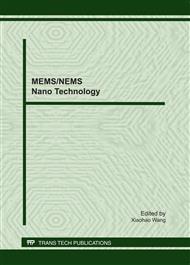p.381
p.387
p.392
p.396
p.401
p.407
p.411
p.417
p.422
Design and Development of the Shrapnel-Borne Meteorological Exploration System Based on MEMS
Abstract:
This paper presents a Shrapnel-borne meteorological exploration system based on MEMS sensor for atmospheric pressure, MEMS sensor for temperature and GPS receiver, and introduces the working principle and composition of the system. This system is carried to given region by shrapnel, and explores the meteorological parameters of temperature, barometric pressure and the speed and direction of wind. A data transfer will transport the data acquired by sensors to user terminal. Then user terminal calculates the speed and direction of wind with GPS data by coordinate transformation algorithm, shows all the results on display interface and draws change curves. Test shows that user terminal can display the results rapidly and accurately. The performances completely meet the design requirements. This system is based on Modular Design, so it can meet the different requirements of different environments. With the use of MEMS sensors, this system contains the characters of economy, high stability and low power consumption.
Info:
Periodical:
Pages:
401-406
Citation:
Online since:
June 2011
Authors:
Price:
Сopyright:
© 2011 Trans Tech Publications Ltd. All Rights Reserved
Share:
Citation:


